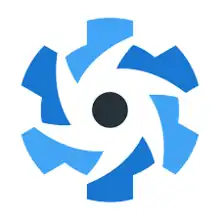Quasar framework
Quasar Framework (commonly referred to as Quasar; pronounced /ˈkweɪ.zɑːr/[4]) is an open-source Vue.JS based framework for building apps, with a single codebase, and deploy it on the Web as a SPA, PWA, SSR, to a Mobile App, using Cordova for iOS & Android, and to a Desktop App, using Electron for Mac, Windows, and Linux. [5][6]
 | |
| Original author(s) | Razvan Stoenescu |
|---|---|
| Initial release | February 2015[1] |
| Stable release | 1.14.7
/ December 7, 2020[2] |
| Repository | Quasar Framework |
| Written in | JavaScript |
| Size | 14.7 KB min+gzip |
| Type | JavaScript framework |
| License | MIT License[3] |
| Website | quasar-framework |
Quasar Framework was created by Razvan Stoenescu and is maintained by him and the rest of the active core team members, who work at various companies such as Lenovo, IntelliView Technologies Inc. and AG Development Services.[7]
Overview
Quasar Framework Quasar’s motto is: Build high-performance VueJS user interfaces in record time. This is possible because you only need to write one authoritative source of code for all platforms: responsive desktop/mobile websites (SPA, SSR + SPA client takeover, SSR + PWA client takeover), PWAs (Progressive Web Apps), mobile apps (that look native) and multi-platform desktop apps (through Electron) and also Browser Extensions.[8]
There’s a component for almost every web development need within Quasar. Quasar is designed with performance & responsiveness in mind, therefore overhead of using Quasar is barely noticeable.[9]
History
Quasar Framework was created by Razvan Stoenescu after working for IBM and Lenovo using constantly new and different software tools to create all the separate types of iOS apps, Android apps, web apps, websites, Windows Desktop apps, Apple Desktop apps, and PWAs. He later summed up his thought process: "I longed for a single framework that would remove all the complexity and produce all these different flavours of apps … from a SINGLE codebase. Unable to locate such a mythical tool, I decided to build it."[10][11]
The first source code commit to the project was dated 2015, and Quasar stable 1.0 release was released in July 2019. The first Quasar conference took place in July 2020.[12]
Versions
| Version | Release date | Title |
|---|---|---|
| 1.14.0 | 2020 Sep 12 | N/A |
| 1.13.0 | 2020 Aug 22 | N/A |
| 1.12.0 | 2020 May 28 | N/A |
| 1.11.0 | 2020 May 10 | N/A |
| 1.10.0 | 2020 May 1 | N/A |
| 1.9.0 | 2020 Feb 11 | N/A |
| 1.8.0 | 2020 Jan 22 | N/A |
| 1.0 | 2019 Jul 3 | N/A |
| 0.17 | N/A | N/A |
| 0.16 | N/A | N/A |
| 0.15 | N/A | N/A |
| 0.14 | N/A | N/A |
| 0.13 | N/A | N/A |
Features
Components
Quasar apps are built using Vue and *.vue Single File Component system, which contain multiple sections: template (HTML), script (Javascript) and style (CSS/Stylus/SASS/SCSS/Less) - all in the same file.[13] The code snippet below contains an example of a Quasar component. The component links properties in a side drawer:
<template>
<q-item
clickable
tag="a"
target="_blank"
:href="link"
>
<q-item-section
v-if="icon"
avatar
>
<q-icon :name="icon" />
</q-item-section>
<q-item-section>
<q-item-label>{ title }</q-item-label>
<q-item-label caption>
{{ caption }}
</q-item-label>
</q-item-section>
</q-item>
</template>
<script>
export default {
name: 'EssentialLink',
props: {
title: {
type: String,
required: true
},
caption: {
type: String,
default: ''
},
link: {
type: String,
default: '#'
},
icon: {
type: String,
default: ''
}
}
}
</script>
Ecosystem
The core library comes with tools and libraries both developed by the core team and contributors.
Official tooling
- Quasar CLI - the global part of the CLI needed for the creation of the apps via development and a build environment for cross-device/ cross-platform application development and distribution.
- Quasar App - the local part of the CLI, which entails the development and build environments. The CLI allows for extremely fast development via a dev server, which enables you to see your changes happen live. Using the build systems of the CLI, you to take your single project and build it out to the multiple platforms and environments Quasar supports (i.e. Web, PWA, Web+SSR, PWA+SSR, Cordova, Capacitor, Electron, Browser Extensions, etc.).
- Quasar UI - the component library within Quasar, with battle tested, high performance components along with numerous directives, helper utilities, plugins and more.
See also
Sources
![]() This article incorporates text from a free content work. Licensed under MIT License License statement/permission on Wikimedia Commons. Text taken from Quasar Framework Guide, Quasar Framework,
This article incorporates text from a free content work. Licensed under MIT License License statement/permission on Wikimedia Commons. Text taken from Quasar Framework Guide, Quasar Framework,
References
- "Why every Vue developer should be excited by Quasar 1.0". Quasar Framework.
- "Quasar Framework Quasar Releases". GitHub. June 14, 2020.
- "Quasar/LICENSE". GitHub. Retrieved May 20, 2020.
- "Guide: What is Quasar?". Quasar Framework. Retrieved May 20, 2020.
- Connell, Danny (2020). Quasar Framework: Cross-Platform Vue JS Vuex & Firebase Apps. Udemy.
- "Guide: What is Quasar?". Quasar Framework. Retrieved May 20, 2020.
- "Meet the Team — Quasar Framework". quasar-framework.org. Retrieved May 20, 2020.
- "What-is-Quasar". Retrieved May 21, 2020.
- "What-is-Quasar". Retrieved May 21, 2020.
- Stoenescu, Razvan (July 3, 2019). "Why every Vue developer should be excited by Quasar 1.0".
- "Guide: What is Quasar?". Quasar Framework. Retrieved May 20, 2020.
- "Quasar.conf 2020". July 5, 2020.
- "Vue Single File Components (SFC) — Quasar Framework". Retrieved May 22, 2020.